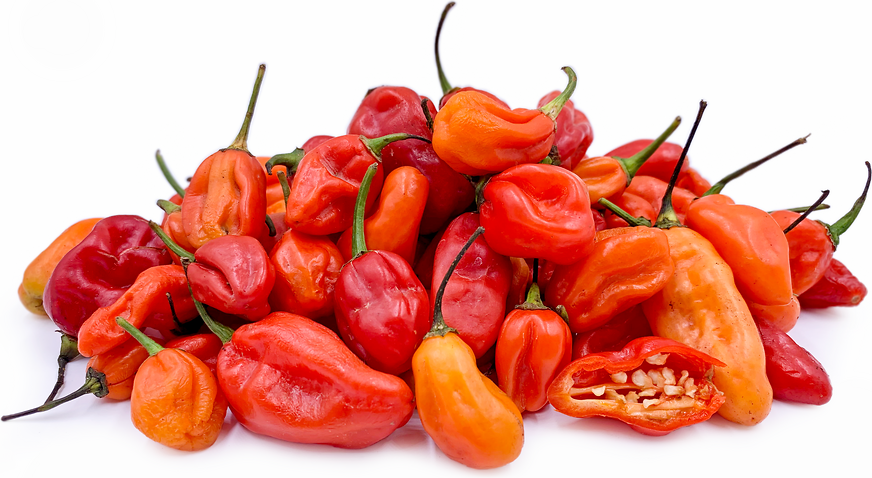


West African Bonnet Chile Peppers
Estimated Inventory, lb : 0
Description/Taste
West African Bonnet chile peppers are tapered, slightly creased pods, averaging 5 to 7 centimeters in length, and have an irregular shape with blunt, curved ends. The skin is waxy, wrinkled, glossy, and firm, maturing from green to orange, yellow, or red when mature. Underneath the surface, the flesh is crisp, pale red or orange, and thin, encasing a central cavity filled with small, round, and flat, cream-colored seeds. West African Bonnet chile peppers have a sweet fragrance and a fruity, floral, and smoky flavor followed by intense, pungent heat.
Seasons/Availability
West African Bonnet chile peppers are available year-round, with a peak season in the summer through fall.
Current Facts
West African Bonnet chile peppers, botanically classified as Capsicum chinense, are a very hot variety that belongs to the Solanaceae or nightshade family. Since the chile pepper’s introduction to West Africa in the 15th and 16th centuries, spicy ingredients have become an integral component in local West African cuisine. There are three primary peppers cultivated in the sixteen countries of West Africa, including Bonnet chile peppers, habanero peppers, and bird chile peppers, with Bonnet chile peppers often ranked as the most used and widespread. There are also many different varieties of Bonnet chile peppers generally labeled under the West African name, found in varying sizes, colors, and shapes, and the peppers are considered very hot, averaging 100,000-350,000 SHU on the Scoville scale. West African Bonnet chile peppers are utilized in a wide variety of raw and cooked applications and are one of the most important flavorings in West African cooking.
Nutritional Value
West African Bonnet chile peppers are an excellent source of vitamins A and C, which are antioxidants that can help improve vision, boost collagen production, and protect the immune system. The peppers also contain magnesium, flavonoids, phytochemicals, and a high amount of capsaicin, which is the chemical compound that triggers the brain to feel the sensation of heat or spice. Capsaicin has been shown to provide anti-inflammatory benefits.
Applications
West African Bonnet chile peppers are best suited for both raw and cooked applications such as boiling, sautéing, and frying. The peppers can be used whole and removed at the end of the cooking process to add minimal heat, or they can be sliced, minced, or chopped for the highest amount of spice and flavor. It is recommended that gloves and goggles are worn when handling the peppers as the high capsaicin content can irritate the skin and eyes. West African Bonnet chile peppers can be tossed into stews, soups, and curries, cooked into rice, chopped into salsas, or cooked into jams. They are also popularly blended into hot sauces, which are served as a condiment at every meal. In West Africa, the peppers are stirred into a porridge known as asaro, that combines boiled and mashed yams with bell peppers, tomatoes, and Bonnet chile peppers. West African Bonnet chile peppers are also traditionally used in fufu, which is a dough ball served with a spicy dipping sauce, or the peppers can be mixed into creamy peanut stews and pepe soups for added heat. West African Bonnet chile peppers pair well with tropical fruits such as melons, papaya, pineapple, coconut, and green mango, tomatoes, onions, okra, corn, yams, plantains, seafood such as shrimp, scallops, and white fish, and meats such as pork, goat, and poultry. The fresh peppers will keep 1-2 weeks when stored whole and unwashed in the crisper drawer of the refrigerator.
Ethnic/Cultural Info
As the consumer market in the United States shifts toward plant-based eating and healthier habits, researchers are looking to West African cuisine as one of the trending food styles of 2020. West African cuisine consists of plant-based proteins, vegetables, and filling starches, and through the use of spicy chile peppers such as the West African Bonnet, many of the dishes are also believed to contribute anti-inflammatory properties. Chile peppers are a foundational ingredient in traditional West African cuisine, along with tomatoes and onions, and the peppers are famous for their use in pepper sauces, which is a condiment that can be added to almost any dish. Pepper sauce is frequently sprinkled over grilled meats, stirred into rice, or served with a dish known as puff-puff, which are fried dough balls. It is also a common homemade sauce found in West African kitchens and is offered at every meal for additional flavoring.
Geography/History
West African Bonnet chile peppers are descendants of original pepper varieties native to the Amazon basin that have been cultivated since ancient times. The original peppers were introduced to West Africa by Portuguese colonizers in the 15th and 16th centuries, and the peppers were naturally bred to develop the West African Bonnet chile peppers seen in markets in the modern-day. West African Bonnet chile peppers can be found at local markets throughout West Africa and are also commonly grown in home gardens for every day, culinary use.
Recipe Ideas
Recipes that include West African Bonnet Chile Peppers. One
| Great British Chefs |
|
Jollo Rice with Kelewele |




